Mick settles low into the crisp snow near Richland, his eyes locked on about 10 runner ducks huddled in the afternoon wind. On command, the stalker chases the fowl into a fluttering blur, lagging just enough to keep from plowing them over.
For Mick, a 6-year-old herding dog, this is practice. His real work picks up with the warmer weather, when he takes his game face to the Canada geese multiplying across some urban and suburban swaths of southwestern Pennsylvania.
It doesn’t take a kill to move along the protected birds, including 200,000 to 250,000 that stay in Pennsylvania year-round, according to the state Game Commission. Often, it takes just a few spirited visits from a well-controlled dog.
“The birds aren’t in any harm at all, but it’s a mind game,” said Brandon Bowen, owner of the West Deer-based Geese Police of Western Pennsylvania, which includes Mick and two other trained border collies. “If [the geese] don’t feel safe on a particular piece of property, then they don’t want to stay there.”
A carpenter by trade, Mr. Bowen bought the franchise in 2009 to diversify his family’s income. His client roster has since ballooned from two to as many as 18 at a time, ranging from such public spaces as parks and playgrounds to private operations that want to keep Canada geese — and their droppings — at bay, Mr. Bowen said.
He gives some credit to a surge in the resident flock of Canada geese, the subspecies that has made Pennsylvania a permanent home since the early 1900s. Fostered in the 1930s to encourage hunting, the birds exploded in numbers and maxed out around 300,000 statewide by the early 2000s, said Ian Gregg of the Game Commission.
“They’re certainly more than edible if you take the time to prepare them right,” said Mr. Gregg, a game management chief who soaks his goose breasts in brine with lemon juice. “They do tend to have a gamy taste if you don’t do some marinating with them.”
Longer goose-hunting seasons and higher bag limits have helped the state knock the resident population toward a target of 150,000, which translates to fewer droppings, less molting and less contamination of public bodies of water, according to the Game Commission.
At the same time, Mr. Gregg said more Canada geese are turning up in urban and suburban communities because it’s tough for hunters to comb those areas, leaving the resident birds to churn out goslings amid fewer hazards. Estimates suggest the reproduction in that flock can approach 20 percent a year.
The new arrivals also mean more goose dung, which can amount to 1.5 pounds a day — per bird. When they’re feeding, their output can reach one dropping every 7 minutes, Mr. Bowen figured.
“It goes in one end and out the other,” said Bob Mulvihill, an ornithologist at the National Aviary on the North Side. Although geese generally don’t care to be around people, he said, they prefer to loaf near water and in short grass.
“That describes a lot of parks and a lot of things that humans create for themselves,” Mr. Mulvihill said.
State and county parks fit the category especially well. Goose droppings accounted for some brief closures of swimming holes last summer at state parks in Pennsylvania, said spokesman Terry Brady.
“Sometimes it’s nasty on some of those state park beaches,” said Mr. Brady, press secretary at the state Department of Conservation and Natural Resources.
He said the fowl weren’t such a problem 30 years ago, long before state parks planted so many shrubs to discourage geese near the beaches. Workers also clean up the droppings and urge visitors not to feed the birds, a common refrain among park managers across the state.
In Allegheny County, North Park has a special permit to treat hundreds of goose eggs with cooking oil each year, preventing hatches that can lead birds to return later in life. County parks director Andy Baechle said adult geese can top a dozen pounds.
“Sometimes they can be aggressive with smaller children,” said Mr. Baechle, who cautioned that the birds may be protective of their nests.
Still, the geese retain plenty of fans. At the Game Commission, Mr. Gregg said they offer a connection to nature, especially for those who can’t explore the wilderness in person.
“It’s a mixed bag. But all in all, I think people enjoy the notion of there being geese around,” said the National Aviary’s Mr. Mulvihill.
Rather than try to push the birds from local waterfronts, he said, organizations could try to lure the geese elsewhere. A cultivated goose habitat along the Monongahela River in the Rankin area might draw the birds away from more populated areas and provide more natural bird-watching opportunities in the process, he said.
“I think you would slowly see them favoring that over the areas where there’s a lot of human traffic,” Mr. Mulvihill said. “Of course, the one potentially complicating factor is whether the geese are being fed where they are.”
Adam Smeltz: asmeltz@post-gazette.com, 412-263-2625 or on Twitter @asmeltz.
First Published: January 15, 2016, 5:00 a.m.
Updated: January 15, 2016, 5:12 a.m.















